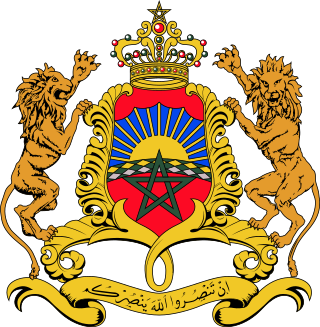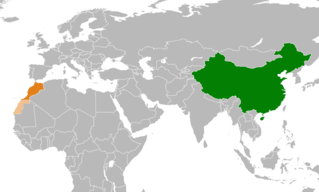Related Research Articles

Casablanca is the largest city in Morocco and the country's economic and business centre. Located on the Atlantic coast of the Chaouia plain in the central-western part of Morocco, the city has a population of about 3.71 million in the urban area, and over 4.27 million in Greater Casablanca, making it the most populous city in the Maghreb region, and the eighth-largest in the Arab world.

Morocco, officially the Kingdom of Morocco, is a country in the Maghreb region of North Africa. It overlooks the Mediterranean Sea to the north and the Atlantic Ocean to the west, and has land borders with Algeria to the east, and the disputed territory of Western Sahara to the south. Morocco also claims the Spanish exclaves of Ceuta, Melilla and Peñón de Vélez de la Gomera, and several small Spanish-controlled islands off its coast. It has a population of roughly 37 million, the official and predominant religion is Islam, and the official languages are Arabic and Berber; French and the Moroccan dialect of Arabic are also widely spoken. Moroccan identity and culture is a mix of Arab, Berber, African and European cultures. Its capital is Rabat, while its largest city is Casablanca.

Morocco is a member of the United Nations and belongs to the African Union, Arab League, Arab Maghreb Union (UMA), Organisation of Islamic Cooperation (OIC), the Non-Aligned Movement and the Community of Sahel-Saharan States (CEN-SAD). Morocco's relationships vary greatly between African, Arab, United States, United Kingdom, Australia, and Western states. Morocco has had strong ties with the West in order to gain economic and political benefits. France and Spain remain the primary trade partners, as well as the primary creditors and foreign investors in Morocco. From the total foreign investments in Morocco, the European Union invests approximately 73.5%, whereas the Arab world invests only 19.3%. As of 2009, many countries from the Persian Gulf and Maghreb regions are also becoming more involved in large-scale development projects in Morocco.

The French protectorate in Morocco, also known as French Morocco, was the period of French colonial rule in Morocco that lasted from 1912 to 1956. The protectorate was officially established 30 March 1912, when Sultan Abd al-Hafid signed the Treaty of Fez, though the French military occupation of Morocco had begun with the invasion of Oujda and the bombardment of Casablanca in 1907.

Mohammedia, known until 1960 as Fedala, is a port city on the west coast of Morocco between Casablanca and Rabat in the region of Casablanca-Settat. It hosts the most important oil refinery of Morocco, the Samir Refinery, which makes it the center of the Moroccan petroleum industry. It has a population of 208,612 according to the 2014 Moroccan census.

The history of the city of Casablanca in Morocco has been one of many political and cultural changes. At different times it has been governed by Berber, Roman, Arab, Portuguese, Spanish, French, British, and Moroccan regimes. It has had an important position in the region as a port city, making it valuable to a series of conquerors during its early history.

Morocco–Russia relations are the bilateral relations between the Kingdom of Morocco and the Russia Federation. Morocco has an embassy in Moscow, while Russia has an embassy in Rabat and a consulate general in Casablanca.

Moroccan trade is still dominated by its main import and export partner France, although France's share in Moroccan trade is declining in favour of the US, the Persian Gulf region and China. If seen as a single entity, the EU is by far Morocco's largest trading partner.

Relations between the People's Republic of China and the Oriental Republic of Uruguay were first established in 1988. Relations were defined as “friendly and cooperative” by the Chinese government. The bilateral relation was promoted to a strategic partnership in 2016.

The People's Republic of China and Lesotho maintain historical, political, economic, trade, aid, healthcare and migration connections.

France–Morocco relations are bilateral relations between Morocco and France. They are part of the France–Africa relations.

India–Morocco relations are the bilateral ties between Morocco and India. Morocco has an embassy in New Delhi, and Consulates in Mumbai and Kolkata. India operates an embassy in Rabat. Both nations are part of the Non-Aligned Movement.
Claude Rijmenans is a retired Belgian ambassador.

Indonesia and Morocco established diplomatic relations in 1960. Both are the Muslim-majority countries; Indonesia is the most populous Muslim country in the world, while Morocco is also a Muslim majority nation. Morocco praised Indonesia as a strong democratic nation, and pointed out that both nations face the same challenges of separatism and terrorism. Diplomatic relations were established in 1960. Indonesia has an embassy in Rabat and a consulate in Casablanca, while Morocco has an embassy in Jakarta. Both nations are members of the World Trade Organization (WTO), Group of 77, Non-Aligned Movement and Organisation of Islamic Cooperation (OIC).

China–Morocco relations refer to the bilateral relations between China and Morocco. China and Morocco established diplomatic relations on November 1, 1958. Morocco establishes 'strategic partnership' with China in 2016, stronger partnership with China is sign that Morocco is seeking political and economic partners far from its traditional markets.
Chinese people in Cape Verde are a community of entrepreneurial migrants who settled on the archipelago beginning in the 1990s to start retail shops. Their presence as immigrants is notable in a country that is known for sending emigrants abroad.

Funduq al-Najjarin is a historic funduq in Fes el Bali, the old medina quarter in the city of Fez, Morocco.
Lahlou is a surname designating one of the great Moroccan families of the old medina of Fez, it is considered, alongside other ancient families of Fez, as the first elite of Morocco. There are branches of the family mainly today in Casablanca or Rabat such as the Lahlou Mimi, Lahlou Nabil, Lahlou Amine or Al-Lahlou. However, some rare branches of the family can be found in Spain such as the Lahlou Torres or even in Algeria and Tunisia.

The Bombardment of Casablanca was a French naval attack taking place from August 5 to 7 in 1907 that destroyed the Moroccan city of Casablanca. France used mainly artillery fire from armored cruisers to bomb the city and targets in the surrounding area, which caused an estimated 1,500 to 7,000 Moroccan deaths. The bombardment of Casablanca opened a western front to the French conquest of Morocco after Hubert Lyautey's occupation of Oujda in the east earlier that year.

Germany–Morocco relations date back to the 19th century. The German Foreign Office describes Morocco as a "central partner of the European Union and Germany in North Africa," and Germany is an important trading partner for Morocco. In the past, however, relations have not always been entirely free of tension.
References
- 1 2 "Les migrations chinoises au Maroc : les commerçants séjourneurs de Casablanca" (in French). Centre Jacques-Berque.
- ↑ "Chinese traders shake up Moroccan vendors". AFP. September 24, 2004.